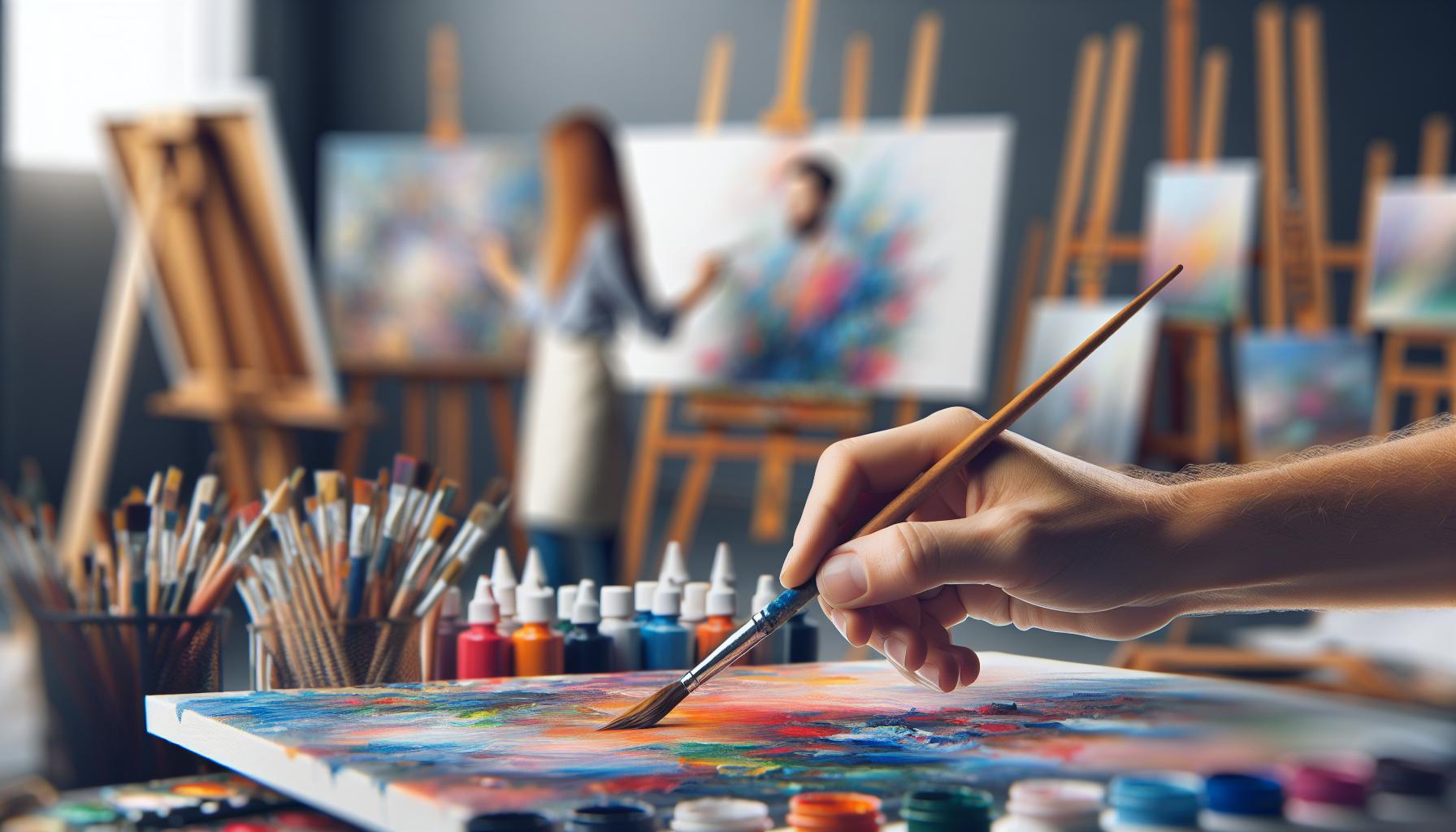Art is a powerful medium that allows artists to communicate emotions and ideas. One of the key techniques they employ is the use of focal points to draw viewers’ attention. By skillfully manipulating the elements of art—such as line, color, shape, texture, and space—artists can create striking compositions that guide the eye to the most important aspects of their work. Understanding how to emphasize a focal point is essential for any artist. It not only enhances the visual impact of a piece but also elevates the overall narrative. Whether through bold contrasts or subtle nuances, the elements of art serve as tools that can transform a simple image into a captivating story.
Artists Can Use Any of The Elements of Art to Emphasize a Focal Point in their Work.
Artists employ various elements of art to emphasize focal points in their work. Each element contributes uniquely to the composition’s overall effectiveness and emotional resonance.
Line
Line serves as the foundational element of art, guiding the viewer’s eye. Artists use straight lines to convey order and stability, while curved lines evoke softness and movement. Creating outlines or implied lines can direct attention toward key areas, enhancing the focal point’s impact.
Shape
Shape defines the boundaries of objects within art. Artists utilize geometric shapes for structure and organization, whereas organic shapes introduce fluidity and complexity. By contrasting shapes, they can draw attention to focal areas, making certain elements stand out in relation to the overall composition.
Color
Color influences mood and perception significantly. Artists strategically select color schemes, using warm colors to create excitement and cool colors for calmness. Utilizing contrasting colors or a limited palette can emphasize focal points, making desired elements more visually striking and memorable.
Texture
Texture adds depth and richness to artistic compositions. Artists can create tactile impressions through techniques such as painting, collage, or mixed media. Varying textures accentuate differences among elements, guiding viewer focus toward specific areas and enriching the overall sensory experience.
Space
Space refers to the area around and between objects in a composition. Artists manipulate negative and positive space to create balance and highlight important elements. By adjusting the proximity of elements, artists can enhance emphasis on focal points, controlling how viewers navigate the artwork visually.
Focal Point in Art
Focal points serve as the centerpiece of artworks, drawing attention and conveying meaning. Artists strategically utilize various elements of art to establish and enhance these key areas.
Definition and Importance
A focal point is the primary area of interest in a piece of art, where the viewer’s eye is naturally drawn. It holds significant importance as it directs attention, creates emphasis, and enhances the overall narrative. A well-defined focal point ensures clarity, enabling viewers to engage with the main themes or subjects the artist wishes to highlight.
How Focal Points Guide the Viewer’s Eye
Focal points guide the viewer’s eye through deliberate use of elements such as line, color, shape, and texture.
- Line: Artists use lines to create pathways, leading the viewer’s gaze towards the focal point. Straight lines offer stability while curved lines introduce movement.
- Color: Intense or contrasting colors can dominate a composition, naturally attracting attention. Warm colors like red and yellow often evoke energy, while cool colors can calm the viewer’s response.
- Shape: Artists employ distinct shapes to demarcate important elements. Geometric shapes like squares may create order, while organic shapes can generate visual interest and complexity.
- Texture: Texture adds depth and tangible qualities, emphasizing focal elements through contrasting surfaces, which encourages exploration of the artwork.
- Space: Manipulating negative space around a focal point enhances its prominence. Ample space creates breathing room, allowing the focal point to stand out clearly against the background.
Techniques for Emphasizing Focal Points
Artists employ various techniques to emphasize focal points within their works. These methods harness the elements of art to direct attention and enhance narrative depth.
Using Color Contrast
Color contrast serves as a powerful tool for emphasizing focal points. Artists often use complementary colors to make important elements stand out. For example, a bright red object against a green background immediately captures attention due to the stark contrast. Dark colors can also enhance lighter tones, further accentuating the focal area. This strategic use of color not only draws the viewer’s eye but also enhances the mood, creating emotional resonance tied to the focal point.
Manipulating Line and Shape
Manipulating line and shape is crucial for defining focal points. Artists use strong, leading lines to guide viewers toward specific areas, creating a visual path. Curved lines can evoke a sense of flow, leading the eye gently to the focal point. Shapes play a significant role as well; unique shapes or prominent geometric forms can attract attention. An irregular shape among uniform shapes can create a visual disruption that encourages viewers to focus. By combining both line and shape, artists establish clear pathways that spotlight essential elements in their compositions.
Exploring Texture and Space
Exploring texture and space greatly adds depth to focal points. Texture creates tactile appeal, inviting closer inspection and increasing interest in the area of focus. Artists utilize varying textures to differentiate between focal points and background, enhancing visibility. Space also plays a key role; ample negative space surrounding a focal point increases its prominence. Busy backgrounds can obscure important elements, whereas open spaces direct focus to the intended subject. This intelligent manipulation of space and texture allows artists to add dimension while highlighting key aspects of their work.
Case Studies of Artists
Examining how artists use elements of art to emphasize focal points reveals diverse techniques across eras. This section looks at both classical and contemporary artists who masterfully highlight focal points in their works.
Classical Artists
Classical artists demonstrated exceptional skill in using elements of art to create compelling focal points.
- Leonardo da Vinci: Da Vinci often employed linear perspective and chiaroscuro. In “The Last Supper,” he used lines and light to guide viewers’ attention directly to Christ at the center. The use of shadow and highlight creates depth, enhancing the focal point’s impact.
- Caravaggio: Caravaggio mastered the technique of tenebrism, where strong contrasts between light and dark direct the viewer’s gaze. In “Judith Beheading Holofernes,” the dramatic lighting emphasizes Judith and her action, drawing focus away from the less illuminated background.
- Rembrandt: Rembrandt effectively used color and texture to enhance focal points. His self-portraits, such as “Self-Portrait with Two Circles,” exhibit rich textures in the fabric and skin tones, drawing attention to his face through a warm color palette contrasted with cooler tones in the background.
Contemporary Artists
Contemporary artists continue to innovate, utilizing modern techniques and concepts to establish focal points.
- Yayoi Kusama: Kusama utilizes polka dots and immersive installations to create striking focal points. In her “Infinity Mirrored Room,” reflective surfaces and repeated patterns create an overwhelming visual experience, guiding viewers’ attention toward the center of the space.
- Banksy: Banksy often employs satirical imagery and bold color contrasts in his street art. Works like “Girl with a Balloon” illustrate how bright colors against a muted background create a clear focal point that engages viewers and evokes emotion.
- Damien Hirst: Hirst’s use of large-scale sculptures and installations often leads the viewer’s eye to a central element. “The Physical Impossibility of Death in the Mind of Someone Living,” featuring a suspended shark in formaldehyde, draws immediate attention through size and placement, emphasizing themes of mortality.
These case studies demonstrate the intentional and skilled application of various elements of art by both classical and contemporary artists to emphasize focal points effectively.
Artists possess the unique ability to manipulate the elements of art to create striking focal points within their work. By understanding how line, color, shape, texture, and space interact, they can effectively guide the viewer’s eye and enhance the narrative of their pieces. This skill not only elevates the visual impact but also deepens the emotional connection to the artwork. Whether through the bold contrasts of color or the intricate play of texture, the intentional emphasis on focal points remains a powerful tool in an artist’s arsenal. As demonstrated through historical and contemporary examples, the thoughtful application of these elements continues to inspire and captivate audiences, ensuring that the art remains a dynamic form of expression.


